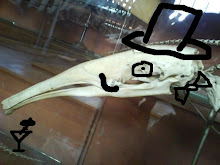Hox code: not new, but something I think is super, simply super.
The marriage of molecular genetics and traditional embryology has resulted in the field of modern developmental biology. In turn, developmental biology is being used to answer evolutionary question, much as comparative embryology was in the past. This is the exciting field of evo-devo (evolutionary developmental biology, you know how these crazy biologists love their snappy titles),
One of the coolest things I think that genetics has told us about evolution is the how many genes are preserved, both in form and functions, though out the taxa of modern mammals. A famous example, if not the most famous example, is that of the HOX genes as they are known in vertebrates, or Homeotic selector genes (HOM) in the fruit fly. These guys are found in a nested pattern along the anterior posterior length (think tail to head) of developing human, mice, frogs, fish, lamprey (ugly ‘primitive’ jawless fish), truncates and fruit fly. So basically the common ancestor of all vertebrates and all insects, apparently a “flattish round worm” that lived, ooo I duuno, ages ago (I really should look that up. Let’s say it was 500 million years ago, but I just made that up. Probably much further back.) had this ‘code’ that specified its arse from its head and kept it has not changed since, more or less.
The nested patter basically means that the domain of expression extends further from the tail to the head in some HOX genes than others. Different areas express a different compliment of of hox genes, and these different areas grown into different structures. The tail expressing more of the HOX genes that those nearer the head. In jawed vertebrates the head doesn’t express any hox genes.
If you use the evil powers possessed by the evil biologist you can extend the expression of the HOX genes more anteriorly. Similarly you can restrict the expression away form areas it is normally expressed. For example, in mice (an humans) the 1st branchial arch (BA1) does not express any HOX genes and develops into the jaw.The 2nd branchial arch (BA2) expresses HOX2A only and develops into the hyoid and other neck type things. Knocking HOX2A out of BA2 leads to it developing suspiciously jaw like structures, and knocking HOXA2 in to BA1 leads to it developing suspiciously hyoid like structures. Cool huh? You can do similar experiments to these in frogs, fish and fruit fly and get similar results, showing that these transcription factors do the same thing in all these diverse animals. I really think this is ace. Properly.
check this review.
Gaunt, S.J. 1994. Conservation in the Hox code during morphological evolution. International Journal of Developmental Biology 38:549-552
its old, but I’d give a load of papers, but that would involve looking them up, and I'm lazy.
Friday, October 28, 2005
Subscribe to:
Posts (Atom)
